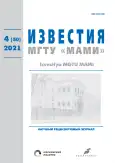Study of existing designs of the peristaltic principle pumps
- Authors: Grishin A.I.1, Lepeshkin A.V.1
-
Affiliations:
- Moscow Polytechnic University
- Issue: Vol 15, No 4 (2021)
- Pages: 9-17
- Section: Original Study Articles
- URL: https://journals.rcsi.science/2074-0530/article/view/105593
- DOI: https://doi.org/10.31992/2074-0530-2021-50-4-9-17
- ID: 105593
Cite item
Full Text
Abstract
Peristaltic pumps are used in a wide variety of applications due to their tightness, ease of maintenance and accurate delivery. Nevertheless, the use of peristaltic pumps is limited by their disadvantages: short service life of the working body and uneven feed. This work provides an overview of the existing design solutions for pumps. The main advantages and disadvantages of the most common modern designs of peristaltic pumps are considered. The developed design solutions are presented. These solutions are designed to extend the service life of the elastic working body of the pump. These include a spiral hose design, where hose life is improved by reducing the number of cyclic compressions using just one roller. Another solution is to operate the pump with incomplete compression of the working element, which reduces the stress values and thereby prolongs the service life of the working element. The special shapes of protrusions in the compression area were developed in order to compensate the decrease in flow caused by the operation of the pump with incomplete compression of the working member. The paper provides an overview of solutions to reduce the uneven flow of a peristaltic pump. The simplest of these is the use of multiple parallel channels. In other designs, the elimination of flow pulsations is achieved with a pneumatic damper. There is also a constructive solution, in which a special algorithm of actuation of five squeeze elements is used for uniform supply, each of which compresses only its own section of the pump working body. Based on the analysis, it is shown that in order to eliminate the disadvantages of peristaltic pumps the various methods are used. Nevertheless, those methods need further improvement.
Full Text
##article.viewOnOriginalSite##About the authors
A. I. Grishin
Moscow Polytechnic University
Author for correspondence.
Email: foxmccloud@rambler.ru
Russian Federation, Moscow
A. V. Lepeshkin
Moscow Polytechnic University
Email: foxmccloud@rambler.ru
PhD in Engineering
Russian Federation, MoscowReferences
- Treutel C. Peristaltic pumps in the food industry. Pumps & Systems. –Birmingham, USA: Cahaba Media Group, July 2007. P. 28−31.
- Allen E.E. Instrument for transfusion of blood. Patent US No 249285, 08.11.1881.
- Porter R., Bradley J.D. Rotary Pump. Patent US No 12753, 17.04.1855
- Loudin T. The evolution of peristaltic pump. Pump engineer. – Zutphen, Netherlands: KCI Publishing, Sep-tember 2007. P. 44−47.
- Mikheyev A.YU. Issledovaniye kharakteristiki i povysheniye nadezhnosti nasosov peristal'ticheskogo printsipa deystviya: dis. … kand. tekhn. nauk [Investigation of the characteristics and increasing the relia-bility of pumps of the peristaltic principle of operation: Dissertation for Degree of PhD in Engineering]. Ufa, 2004. 168 p.
- Kondrashchenko V.I., Emelianova I.A., Chaika D.O. Features of the Use of a Universal Hose Concrete Pump in the Construction Site // OP Conf. Series: Earth and Environmental Science vol. 272 issue 3 32107. IOP Publishing, 2019, 6 p. doi: 10.1088/1755-1315/272/3/032107
- Poryadkov L.F. Rabochaya trubka dlya peristal'ticheskogo nasosa [Operating tube for peristaltic pump]. Patent na izobreteniye No 309294, Rossiyskaya Federatsiya. Opublikovano 27.10.2007. Byul. No 30.
- Tarasov YU. D. Peristal'ticheskiy nasos [Peristaltic pump]. Patent na izobreteniye No 2290536, Rossiyskaya Federatsiya. Opublikovano 27.12.2006. Byul. No 36.
- Grishin A.I. Influence of the cross-sectional shape and length of the compressible sections on the charac-teristics of a linear peristaltic pump. Izvestiya MGTU «MAMI». 2021. No 2(48), pp. 9−17 (in Russ.). doi: 10.31992/2074-0530-2021-48-2-9-17
- Kopchenkov V.G. Treniye i iznashivaniye elastomerov v usloviyakh kontaktno-dinamicheskogo nagru-zheniya: dis. … dokt. tekhn. nauk [Friction and wear of elastomers under dynamic contact loading: Disser-tation for Degree of DrSc in Engineering]. Stavropol', 2004. 424 p.
- Skafte-Pedersen P., Hemmingsen M., Blaga F.S., Bruus H., Dufva M. A self-contained, programmable mi-crofluidic cell culture system with real-time microscopy access // Biomed Microdevices. Springer Science, Business Media. 2011. P. 385−399. doi: 10.1007/s10544-011-9615-6
- Grishin A.I. Method for calculating the characteristics of a linear peristaltic pump with incomplete com-pression of the working body. Izvestiya MGTU «MAMI». 2018. No 3, pp. 21–31 (in Russ.).
- Aznabayev B.M., Barakov V.N., Ramazanov V.N., Mukhamadeyev T.R., Bikchurayev D.R., Dibayev T.I. As-piratsionnyy nasos dlya oftal'mokhirurgicheskikh system [Ophthalmic surgery suction pump]. Patent RF 2434608 C1; opubl. 27.11.2011. Byul. No 33.
- Shlegel' I.F. Peristal'ticheskiy nasos [Peristaltic pump]. Patent RF No 2282056 S2; opubl. 20.08.2006. Byul. No 23.
- Daniel Minarik D., Beck J.E. Peristaltic pump having means for reducing flow pulsation. Patent US No 5257917, 02.11.1993.
- Jönsson A., Toppi A., Dufva M. The FAST Pump, a low-cost, easy to fabricate, SLA-3D-printed peristaltic pump for multi-channel systems in any lab // HardwareX. Elsevier. 2020, 45 p. doi: 10.1016/j.ohx.2020.e00115
- Liermann M. Active Pneumatic Pulsation Damper for Peristaltic Pump Flow Loops // Proceedings of the 2016 Bath/ASME Symposium on Fluid Power and Motion Control, FPMC2016, Bath, England. 20 16, 9 p.
- Hoffmeier K.L., Hoffman D., Feller K.-H. A First Inherently Pulsation Free Peristaltic Pump // 58th Ilmenau scientific colloquium, Technische Universität Ilmenau, 08 – 12 September 2014. 11 p.
- Lin Q., Yang B., Xie J., Tai Y. Dynamic simulation of a peristaltic micropump considering coupled fluid flow and structural motion // Journal of micromechanics and microengineering. – UK, Institute of physics pub-lishing: IOP Publishing Ltd, 2006. No 17. P. 220−228.
- Trencle F., Haeberle S., Zengerle R. Normally-closed peristaltic micropump with reusable actuator and dis-posable fluidic chip // Sensors and Actuators B: Chemical. – Elsevier Science, 2011. 154 P. 137−141. doi: 10.1016/j.snb.2009.12.069
Supplementary files


















